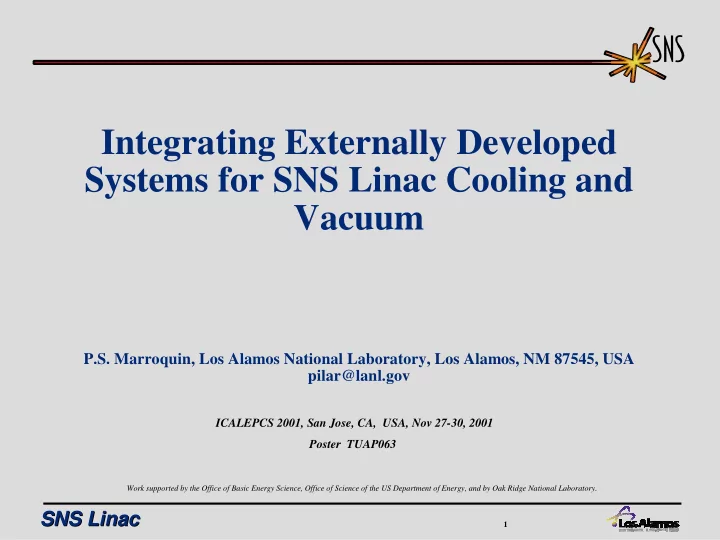

Integrating Externally Developed Systems for SNS Linac Cooling and Vacuum P.S. Marroquin, Los Alamos National Laboratory, Los Alamos, NM 87545, USA pilar@lanl.gov ICALEPCS 2001, San Jose, CA, USA, Nov 27-30, 2001 Poster TUAP063 Work supported by the Office of Basic Energy Science, Office of Science of the US Department of Energy, and by Oak Ridge National Laboratory. SNS Linac SNS Linac 1
Abstract External contractors are developing the local cooling and vacuum control systems for the Spallation Neutron Source (SNS) linac. Soon these systems will be integrated into the facility-wide controls system. Allen-Bradley Logix5000 series programmable controllers, populated with appropriate input/output modules, were selected as the local controllers. These controllers will be interfaced to the facility-wide control system via VME systems with PowerPC processors running the Wind River VxWorks operating system and Experimental Physics and Industrial Control System (EPICS) front-end controller software. This paper describes the interface and integration issues driven by project, cooling system and vacuum system requirements and hardware selections. SNS Linac SNS Linac 2
Brief Background SNS DTL and CCL RCCS and Vacuum Control Systems Intel based Linux EPICS Operator Screens Archiving OPIs Logging Alarm Management Boot Hosts MPS Event Link/RTDL Ethernet Monitor, Control, Interlocks Monitor, Control, Interlocks Monitor, Control, Interlocks Monitor, Control, Interlocks PowerPC VME s s k k VxWorks c c o o l l r r EPICS IOC e e t t n n IOCs I I Channel Access e e r r i i w w Supervisory Control d d r r a a Alarm Checking H H Tank 1 Tank 1 Mod 1 Mod 1 MPS local inputs Event Link/RTDL 2 2 2 2 EtherNet/IP to PLCs RS-485 3 RS-485 3 RS-485 3 3 I/O I/O I/O I/O 4 4 Programmable LLRF LLRF 4 4 I/O I/O I/O I/O Controllers 5 5 LLRF LLRF AB ControlLogix I/O I/O I/O I/O I/O Modules 6 6 LLRF LLRF Ladder Logic I/O I/O I/O I/O Local Control LLRF LLRF Closed Loop Control I/O RGAs I/O RGAs PID LLRF Interlocks Other Devices Other Devices I/O I/O EtherNet/IP to/from IOC LLRF DTL RCCS DTL Vacuum CCL RCCS CCL Vacuum SNS Linac SNS Linac 3
Issues Interface Between IOC and PLC • Selection of a communication protocol, EtherNet/IP • Creating and reaching agreement on signal lists • Mapping IOC process variables (PV) to PLC tags • IOC issuing commands in the form of requests • Creating and naming tags for transfer to IOC • Optimizing data transfer between PLC and IOC SNS Linac SNS Linac 4
Issues (continued) Serial Based Devices • Decision to use serial ports on IOC rather than PLC • Device driver development • Serial type selected , RS-485, and network layout • Distributed control SNS Linac SNS Linac 5
Issues (continued) Control loops over Ethernet • PID loops dispersed over IOCs and PLCs on non-dedicated networks SNS Linac SNS Linac 6
Issues (continued) EPICS displays vs. PLC displays • Cost, development and maintenance of local PanelView displays • Redundant control screens on different platforms SNS Linac SNS Linac 7
Issues (continued) Alarm Checking and Management • The IOC as the appropriate location for alarm checking functions versus the PLC • Alarm limit parameter maintenance in one place SNS Linac SNS Linac 8
Conclusion The criteria used to make these decisions include: • Meet system requirements • Provide reliable operation • Minimize equipment cost • Minimize development and maintenance efforts By working closely with external systems integrators we are able to consider these issues from an integrated system perspective. SNS Linac SNS Linac 9
Recommend
More recommend